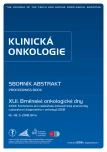Biomonitoring of Work with Genotoxic Substances and Factors in a Cancer Treatment Facility
Authors:
M. Petrovová 1,2; P. Musilová 3; M. Svoboda 4,5; I. Selingerová 6; R. Goněc 7,8; H. Hradská 3; D. Kadlčíková 3; M. Vozdová 3; P. Brhel 2; J. Rubeš 3
Authors‘ workplace:
Ambulance pracovně lékařských služeb, Masarykův onkologický ústav, Brno
1; Klinika pracovního lékařství LF MU a FN u sv. Anny v Brně
2; Výzkumný ústav veterinárního lékařství, v. v. i., Brno
3; Klinika komplexní onkologické péče, Masarykův onkologický ústav, Brno
4; Oddělení epidemiologie a genetiky nádorů, Masarykův onkologický ústav, Brno
5; Oddělení laboratorní medicíny, Masarykův onkologický ústav, Brno
6; Ústavní lékárna, Masarykův onkologický ústav, Brno
7; Úsek klinických hodnocení, Masarykův onkologický ústav, Brno
8
Published in:
Klin Onkol 2018; 31(Supplementum1): 163-167
Category:
Article
Overview
Background:
A long-term occupational exposure of healthcare staff to cytostatics and ionizing radiation is associated with a possible manifestation of their genotoxic, carcinogenic and teratogenic effects.
Material and methods:
A total number of 101 employees working with cytostatics or ionizing radiation were examined (some of them repeatedly) in a cancer treatment facility. The control group consisted of 119 persons excluded from the risk exposure. Fluorescence in situ hybridization with three pairs of whole-chromosomal probes and a pancrossomeric probe was used and the translocation frequency was determined.
Results:
The total number of chromosomal rearrangements of healthcare professionals and control group correlates with age. Taking into account the age dependence, an increased level of chromosomal reconstruction was found in the case of 11 individuals, 10 of which were female, working on the positions of pharmacist, general nurse, physician. A total of 9 of those case involved the work with cytostatics. Five of these cases were re-examined two years later and the observed levels dropped to the control level.
Conclusion:
The results of biomonitoring should be evaluated on a group basis and individually, taking into account the personal history and possible non-professional effects on individuals – in particular those related to specific environmental measurement results.
Key words:
preventive medicine – occupational exposure – cytostatic agents – chromosome aberrations – in situ hybridization – fluorescence
The authors declare they have no potential conflicts of interest concern ing drugs, products, or services used in the study.
The Editorial Board declares that the manuscript met the ICMJE recommendation for biomedical papers.
This work was supported by project of Ministry of Health Czech Republic. reg. No. 15-33968A.
Submitted:
12. 4. 2018
Accepted:
16. 4. 2018
Sources
1. Piler P. Významná protinádorová léčiva: Analytická stanovení a hodnocení rizik profesní expozice. Bakalářská práce. Brno: Masarykova univerzita, Přírodovědecká fakulta 2008.
2. Chaloupka J, Boušová K, Bubeníčková J et al. Závodní preventivní péče o pracující v riziku cytostatik ve Fakultní nemocnici Hradec Králové. Pracov Lék 2011; 63 (2): 72–78.
3. Linet MS, Kim KP, Miller DL et al. Historical review of occupational exposures and cancer risks in medical radiation workers. Radiat Res 2010; 174 (6): 793–808.
4. Odráška P, Doležalová L, Gorná L et al. Occupational exposure of healthcare professionals to antineoplastic agents in Masaryk Memorial Cancer Institute. 14th Interdisciplinary Toxicology Conference TOXCON, Brno. Interdiscip Toxicol 2009; 2 (2): Abstr. 132.
5. Tucker JD, Morgan WF, Awa AA et al. A proposed system for scoring structural aberrations detected by chromosome painting. Cytogenet Cell Genet 1995; 68 (3–4): 211–221. doi: 10.1159/000133916.
6. Lucas JN, Awa A, Straume T et al. Rapid translocation frequency analysis in humans decades after exposure to ionizing radiation. Int J Radiat Biol 1992; 62 (1): 53–63.
Labels
Paediatric clinical oncology Surgery Clinical oncologyArticle was published in
Clinical Oncology

2018 Issue Supplementum1
Most read in this issue
- MicroRNA Analysis for Extramedullary Multiple Myeloma Relapse
- A Development and Overview of the Use of Chemotherapy and the Role of Radiotherapy and Surgery in Patients with Newly Diagnosed Pancreatic Tumor and Cancer in the Current 5-year Center Practice
- Flow Cytometric Analysis of Nucleoside Transporters Activity in Chemoresistant Prostate Cancer Model
- MicroRNAs in Prediction of Response to Radiotherapy in Head and Neck Cancer Patients – Pilot Study
